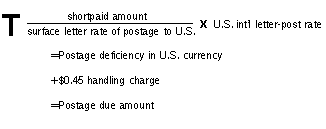|
Postal Explorer > International Mail Manual - Issue 32 > 7 Treatment of Inbound Mail > 730 Shortpaid Mail to the United States
730 Shortpaid Mail to the United States
731 Computation of Postage Due
a. The postal service of the country of origin identifies and marks
shortpaid mail with a T stamp. Next to the T is a fraction that consists of
the amount of postage deficiency (expressed in its own currency)
divided by the country's international surface letter rate at the first
increment.
b. The receiving exchange office in the United States multiplies the T
fraction by the U.S. international letter rate to determine the shortpaid
amount in U.S. currency. This amount, plus a $0.50 handling charge,
accounts for the postage-due amount to be collected on delivery. The
postage-due formula is:

c. The receiving exchange office in the U.S. will imprint stock rubber
stamp R-1300-4, Postage Due . . . Cents, and enter the amount of
postage due.
d. The delivery office will collect postage-due mail in accordance with
DMM 604 and Handbook F-1, Post Office Accounting Procedures.
732 Shortpaid Letters and Cards From Canada
Shortpaid mail from Canada is marked with a T in a circle with the actual
amount to be collected entered in the circle. No handling charge is assessed
or collected on shortpaid mail from Canada.
If an item bears U.S. postage, the delivery office must allow credit for its
value when postage due is collected.
|



